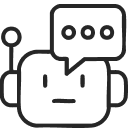Generative AI Statistics: Market Size & Usage Trends (2025)
- August 14, 2024
-
4121 Views
- by Ishan Vyas

Introduction
Generative AI is a fast-expanding and interesting area of technology. Making models capable of producing fresh content—text, images, music, even code—is part of it. Trained on enormous volumes of data, these artificial intelligence algorithms may generate outputs that frequently seem to be human creations. From entertainment to healthcare, generative AI is applied in various sectors to produce creative ideas and improve user experiences with outstanding powers. This guide explores some key statistics of generative AI, showing its impact and future potential.
Tools like Stable Diffusion and ChatGPT as well as generative artificial intelligence (GenAI) have entirely transformed the game. Leveraging Large Language Models (LLMs), GenAI is a fascinating field of artificial intelligence. To produce fresh content encompassing text, photos, audio, and video, these models are taught on vast volumes of text, images, audio, and video.
1.The Current Generative AI State of the Global Market
The global AI market is currently experiencing massive growth, revolutionising various sectors with its advanced capabilities. A key driver of this transformation is the rise of generative AI development services, which are pushing the boundaries of what AI can achieve. These services are enabling businesses to create more sophisticated and personalised solutions, thereby enhancing user experiences. As AI continues to evolve, it promises to bring even more innovative solutions and significant economic benefits to businesses and consumers worldwide. With generative development services at the forefront, the Role of AI in the future looks even more promising and impactful.
-
The Statistics of Generative AI in 2024
Generative AI will have a significant impact across all industry sectors. As a percentage of their revenue, the banking, high-tech, and life sciences sectors may be most affected by generative AI. If the use cases were completely implemented, the technology could contribute $200 billion to $340 billion in value yearly to the banking sector. The potential impact in retail and consumer packaged products is estimated to be between $400 billion and $660 billion annually.
(Source: Mckinsey)
-
Funding for generative AI software
Startups emphasizing Generative AI have witnessed a significant rise in financing in the last several years. Investors fall roughly $25 billion only in 2023 alone. With $18.8 billion raised in just the first five months, the trend keeps strong in 2024 and points to yet another fantastic year.
(Source:dealroom.co)
-
Generative AI Market Size Statistics
The market for generative AI was valued at USD 13.9 billion in 2023 and is expected to reach USD 208.8 billion by 2032, expanding at a compound annual growth rate of 35.3% between 2024 and 2032.
Revenue of the global generative AI market is expected to reach USD 208.8 USD billion by 2032, exhibiting an impressive compound annual growth rate (CAGR) of 35.3% from 2024 to 2032.
In 2023, the revenue generated by the North America generative AI market exceeded US$ 5.7 billion.
Last year, the USA saw impressive private funding of over USD 52.9 billion in AI technology.
(Source: acumenresearchandconsulting.com)
2. Generative AI Statistics in Software Development
- 95% of software developers are using generative AI tools to write new code.
In a survey of 1,000 engineers and developers across all major industries, Sourcegraph discovered that the vast majority are experimenting with AI software code.
They found that 95% of developers produce new code for their applications using generative AI tools like GitHub Copilot, ChatGPT, and Cody.
This is encouraging because developers say they spend most of their time 56% to be exact—maintaining and improving already-written code.
Developers only spend 14% of their time writing new code and 30% of their time on non-code-related tasks.
3. Generative AI Industry-Wise Statistics
-
Generative AI Statistics on E-Commerce
The e-commerce market for generative AI was valued at USD 721.31 million in 2023, increased to USD 833.11 million in 2024, and is projected to grow to around USD 3,519.84 million by 2034. From 2024 to 2034, the market is expected to grow at a strong 15.5% compound annual growth rate.
The generative AI stats in the e-commerce market in the US was valued at USD 218.21 million in 2023 and is expected to grow at a compound annual growth rate (CAGR) of 16.1% from 2024 to 2034, or around USD 1,124.58 million.
-
Generative AI Statistics on Education
According to GMA, the learning platform and virtual facilitators segment of the AI market is predicted to grow at a CAGR of more than 20% between 2023 and 2032 as a result of AI teachers using technology to improve student learning standards. This growth is further supported by the integration of AI video meetings, which enable seamless, interactive learning experiences, bridging geographical gaps and enhancing collaboration among students and educators.
Furthermore, 15% of artificial intelligence (AI) sales are anticipated to come from the corporate learning segment of the education market by 2032. In the next ten years, there will be a noticeable increase due to the growing popularity of AI schools.
With 91% accuracy, AI-enhanced Chatbots provided personalized help and guidance to students (The University of Murcia chatbot case).
62% Increase in Test Scores Through Adaptive Learning (Knewton Case Study).
AI Improved Students’ Grades by 30% While Reducing Their Anxiety by 20% (Intelligent Tutoring System (ITS) implementation case)
Over 800,000 students across Latin America, Korea, and Japan have improved their English by practicing with AI voice technology (AI startup integration – Edwin.ai case)
(Source: springsapps.com)
-
Generative AI Statistics on Healthcare
Generative AI stats in Healthcare Market was at USD 1.8 billion in 2023 and is anticipated to reach USD 22.1 billion by the end of 2032. (Source: Global Market Insights)
Generative AI represents a significant new tool that can aid in unlocking a portion of the unrealized $1 trillion improvement potential within the healthcare industry. (Source: McKinsey)
72% of healthcare leaders expressed trust in AI’s ability to automate administrative tasks, thus enabling clinicians to concentrate more on patient care. (Source: Master of Code)
4. Impact of Generative AI on Employment and Skill Development
-
Job Market Dynamics:
A notable trend is that companies are increasingly posting jobs related to Generative AI. LinkedIn reports that job postings on the platform mentioning GPT or ChatGPT have increased 21x since November 2022, when OpenAI first released its AI chatbot into the world.
-
Employment Creation vs. Displacement:
According to a McKinsey analysis, between 2016 and 2030, advances in artificial intelligence may impact 15% of the world’s workforce. This figure includes both the development of new employment requiring AI skills and job displacement from automation.
-
Trends in Skill Development and Education:
Changing Requirements for Skills: The increasing integration of AI into several industries has led to a shift in the skill requirements for numerous vocations. The previous generative AI stats, which showed an increase in postings connected to AI, indicate that there is a growing need for AI literacy and the capacity to collaborate with AI systems.
(Source: hatchworks.com/)
5. GenAI Tools: ChatGPT Statistics
ChatGPT has over 180.5 million monthly users as of July 2024.
- ChatGPT is mostly adopted by marketing and advertising professionals at a rate of 37%
- 27% of industry professionals used ChatGPT for work within the first month of its release
- 43% of industry professionals have used ChatGPT in the workplace
- OpenAI spends approximately $700,000 every day to operate ChatGPT.
- 7 nations, including China and Russia, cannot access ChatGPT.
- ChatGPT reached 1 million users in just five days after its launch.
(Source:demandsage.com)
Conclusion
The generative AI statistics and trends (2024) make it abundantly evident that AI has a significant and prevalent impact. AI’s influence is seen in everything from changing consumer behavior and learning methods to challenging business climates and employment markets. As generative AI development services continue to evolve, they play a critical role in shaping these changes and driving innovation.
we stand on the brink of this AI-driven era, it is imperative for businesses, consumers, and policymakers to collaborate, ensuring that principles of equity, transparency, and human-centric values guide AI’s evolution. AI’s journey is far from over, and its true potential lies in our collective hands.





 SaaS Development
SaaS Development Web Application Development
Web Application Development Mobile Application Development
Mobile Application Development Custom Software Development
Custom Software Development Cloud Development
Cloud Development DevOps Development
DevOps Development MVP Development
MVP Development Digital Product Development
Digital Product Development Hire Chatbot Developers
Hire Chatbot Developers Hire Python Developers
Hire Python Developers Hire Django Developers
Hire Django Developers Hire ReactJS Developers
Hire ReactJS Developers Hire AngularJS Developers
Hire AngularJS Developers Hire VueJS Developers
Hire VueJS Developers Hire Full Stack Developers
Hire Full Stack Developers Hire Back End Developers
Hire Back End Developers Hire Front End Developers
Hire Front End Developers AI Healthcare Software Development & Consulting
AI Healthcare Software Development & Consulting Healthcare App Development
Healthcare App Development EHR Software Development
EHR Software Development Healthcare AI Chatbot Development
Healthcare AI Chatbot Development Telemedicine App Development Company
Telemedicine App Development Company Medical Billing Software Development
Medical Billing Software Development Fitness App Development
Fitness App Development RPM Software Development
RPM Software Development Medicine Delivery App Development
Medicine Delivery App Development Medical Device Software Development
Medical Device Software Development Patient Engagement Software Solutions
Patient Engagement Software Solutions Mental Health App Development
Mental Health App Development Healthcare IT Consulting
Healthcare IT Consulting Healthcare CRM Software Development
Healthcare CRM Software Development Healthcare IT Managed Services
Healthcare IT Managed Services Healthcare Software Testing services
Healthcare Software Testing services Medical Practice Management Software
Medical Practice Management Software Outsourcing Healthcare IT Services
Outsourcing Healthcare IT Services IoT Solutions for Healthcare
IoT Solutions for Healthcare Medical Image Analysis Software Development Services
Medical Image Analysis Software Development Services Lending Software Development Services
Lending Software Development Services Payment Gateway Software Development
Payment Gateway Software Development Accounting Software Development
Accounting Software Development AI-Driven Banking App Development
AI-Driven Banking App Development Insurance Software Development
Insurance Software Development Finance Software Development
Finance Software Development Loan Management Software Development
Loan Management Software Development Decentralized Finance Development Services
Decentralized Finance Development Services eWallet App Development
eWallet App Development Payment App Development
Payment App Development Money Transfer App Development
Money Transfer App Development Mortgage Software Development
Mortgage Software Development Insurance Fraud Detection Software Development
Insurance Fraud Detection Software Development Wealth Management Software Development
Wealth Management Software Development Cryptocurrency Exchange Platform Development
Cryptocurrency Exchange Platform Development Neobank App Development
Neobank App Development Stock Trading App Development
Stock Trading App Development AML software Development
AML software Development Web3 Wallet Development
Web3 Wallet Development Robo-Advisor App Development
Robo-Advisor App Development Supply Chain Management Software Development
Supply Chain Management Software Development Fleet Management Software Development
Fleet Management Software Development Warehouse Management Software Development
Warehouse Management Software Development LMS Development
LMS Development Education App Development
Education App Development Inventory Management Software Development
Inventory Management Software Development Property Management Software Development
Property Management Software Development Real Estate CRM Software Development
Real Estate CRM Software Development Real Estate Document Management Software
Real Estate Document Management Software Construction App Development
Construction App Development Construction ERP Software Development
Construction ERP Software Development





